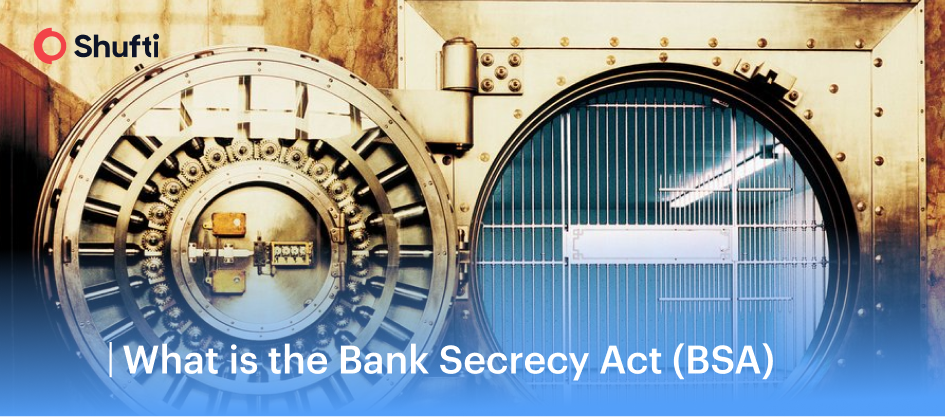What is the Bank Secrecy Act (BSA)

- 01 What is the Purpose of the Bank Secrecy Act?
- 02 Who Must Comply With the BSA?
- 03 Who is exempted from the AML Compliance program requirement under the BSA?
- 04 What Are the Five Pillars of a Strong BSA/AML Program?
- 05 What Types of Reports Are Required Under the Bank Secrecy Act (BSA)?
- 06 How Is the BSA Enforced, and What Are the Penalties?
- 07 What Are the Latest Developments and Emerging Trends in BSA Compliance?
- 08 Final Thoughts
In an era of rapid digital transactions and globalized finance, the world faces an ongoing battle against financial crime. From money laundering and terrorism financing to tax evasion and cyber fraud, illicit actors exploit systems by hiding behind the layers of complexity. The Bank Secrecy Act (BSA), also known as the Currency and Foreign Transactions Reporting Act of 1970, is the United States’ first and most important defense mechanism against such crimes.
The Bank Secrecy Act is enforced primarily by the Financial Crimes Enforcement Network, better known as FinCEN, under the U.S. Department of the Treasury. The BSA mandates financial institutions to keep records and report certain transactions to help detect and deter criminal activity. It remains the cornerstone of anti-money laundering (AML) compliance, shaping how banks, credit unions, fintech firms, and other financial intermediaries protect the integrity of the financial system.
What is the Purpose of the Bank Secrecy Act?
The BSA was enacted to increase transparency in financial dealings and prevent the U.S. financial system from being used for illegal purposes. The core purpose of BSA is:
- Detect and prevent money laundering by requiring financial institutions to monitor and report suspicious activity.
- Support law enforcement by providing transaction data that can reveal links between criminals, organizations, and sources of funds.
- Protect the economy by discouraging illicit use of the banking system.
- Strengthen national security by disrupting terrorism financing and corruption.
In simple terms, the BSA acts as the eyes and ears of regulators and law enforcement, ensuring that financial institutions act as gatekeepers against unlawful money flows.
Who Must Comply With the BSA?
The BSA applies broadly to “financial institutions,” a term that encompasses more than traditional banks. A few of the many entities subject to the Act’s obligations include Commercial and savings banks, Credit unions, Money services businesses (MSBs) such as remittance providers or currency exchanges, Broker-dealers in securities and futures, Casinos and card clubs, Mutual funds, Crypto firms, stable coins which is added under the new Genius Act and Fintechs that handle customer funds or facilitate transactions. Each institution’s specific obligations depend on its nature, size, and risk exposure.
Who is exempted from the AML Compliance program requirement under the BSA?
A Few Financial institutions are subject to exemption under the BSA. These institutions include
- Pawnbroker
- Travel agency
- Telegraph company
- Seller of vehicles, including automobiles, airplanes, and boats
- Person involved in real estate closings and settlements
- Commodity pool operator
- Commodity trading advisor
- Investment company
These institutions are only exempted from the requirement of a strong AML compliance program; however, they are still required to file a report of any suspicious activity.
What Are the Five Pillars of a Strong BSA/AML Program?
Under the Bank Secrecy Act, a successful AML compliance program is based on the five pillars. These aspects ensure that the institutions are not only fulfilling the requirements of the regulator but also taking practical steps to reduce the risks of financial crime.
1. Designation of a BSA Compliance Officer
A qualified individual must be appointed to manage and monitor daily AML compliance efforts. The compliance officer oversees the implementation of the compliance program, ensures alignment with regulations, and serves as the main point of contact for regulators and law enforcement agencies.
2. Internal Controls
Establishing internal controls is the most important and diverse pillar of BSA, as each business has different mechanisms to operate. Financial institutions that are subject to the act are required to put in place written procedures, policies, and internal controls in the form of a strong AML compliance program that is aimed at identifying and reporting suspicious transactions that are suitable for their operations. These controls must entail defined customer onboarding processes, transaction monitoring workflow, reporting, and recordkeeping.
3. Ongoing Training for Employees
The BSA/AML requirements, red flag identification, and reporting protocols should be provided to all concerned workers as continuous, role-specific training. This develops a culture of compliance and makes the staff aware of the emerging risks and typologies.
4. Independent Testing
An independent audit or testing function, internal or external, must periodically evaluate the AML program’s effectiveness. Testing ensures that internal controls are operating properly and identifies any gaps or weaknesses.
5. Customer Due Diligence (CDD)
The fifth pillar, which has been introduced as a result of regulatory amendments, stipulates that financial institutions are to identify and verify the identity of customers as well as the beneficial owners of the company via a robust customer identification program. This step helps prevent criminals from concealing illicit funds behind anonymous shell companies.
Customer Due Diligence also involves understanding the customer’s nature, purpose, and risk profile to monitor for unusual or inconsistent activity.
What Types of Reports Are Required Under the Bank Secrecy Act (BSA)?
Bank Secrecy Act (BSA) mandates financial institutions and relevant businesses to report transactions, which may aid in detecting and preventing money laundering, terrorist financing, and other unlawful financial transactions.. These reports create a transparent trail of financial transactions for regulators and law enforcement agencies.
Currency Transaction Report (CTR)
All cash transactions above $10,000 in a single business day require the filing of a CTR. If a person makes more than one small transaction that adds up to $10,000 or more would also mandate the financial institution to issue a CTR. This CTR is termed as FinCen Form 112. This helps authorities monitor large cash movements that could signal money laundering. Some low-risk customers, such as government entities, may be exempted.
Suspicious Activity Report (SAR)
SAR is filed if the compliance officer or the relevant authority suspects any transaction that might be fraudulent. A transaction may appear unusual, lack a clear business purpose, or suggest possible fraud, money laundering, or terrorist activity. SAR report needs to be filed on the basis of suspicion without the requirement of substantial proof. SARS are classified and highly important in informing law enforcement agencies about concealed or developing threats.
Foreign Bank and Financial Accounts Report (FBAR)
U.S. persons must file an FBAR (FinCEN Form 114) if they hold foreign financial accounts totaling more than $10,000 at any time during the year. This report exposes offshore accounts allegedly used to hide assets or evade taxes, strengthening international financial transparency.
Currency and Monetary Instrument Report (CMIR)
A CMIR is required when anyone carries, ships, or mails over $10,000 in currency or monetary instruments into or out of the United States. It helps authorities detect cross-border cash smuggling and global money laundering operations.
Form 8300 – Cash Payments Over $10,000
Businesses that receive more than $10,000 in cash from a buyer in one or more related transactions must file Form 8300. This expands anti-money-laundering regulation to areas such as real estate, car sales, and jewelry, where huge cash transactions are common practice.
Funds Transfer and Travel Rule Records
In the case of electronic transactions involving the transfer of money over $3,000 or higher, the institutions are required to record and store the information of the sender and recipient. This requirement is also referred to as the FATF Travel Rule, and it provides the ability to trace the payment information all the way through the transfer process, eliminating loopholes that can be exploited by criminals.
How Is the BSA Enforced, and What Are the Penalties?
BSA is enforced by FinCEN and other federal banking regulators jointly. Institutions that are non-compliant can be subjected to:
- Civil fines against violations in recordkeeping or reporting are, at times, in the millions of dollars.
- Willful or egregious violations are subject to criminal penalties, such as imprisonment for those involved.
- Regulatory measures, e.g., consent orders, increased supervision, or limitations of business operations.
- Reputational losses that may damage investor and customer confidence.
The regulators do not only focus on whether there is a compliance program in place, but also whether it is effective. Even a check-the-box program that does not detect actual risks may lead to harsh penalties.
What Are the Latest Developments and Emerging Trends in BSA Compliance?
BSA has been constantly changing to cope with the contemporary risks of financial crime. Several trends are influencing its enforcement and implementation:
1. Digital Assets and Cryptocurrency Oversight
Blockchain transactions and virtual currencies have opened up new channels through which money laundering can take place. Regulators are now applying the coverage of BSA to virtual asset service providers who must have an AML program, verify the identity of their customers, and file CTRs and SARs as with traditional institutions.
2. Artificial Intelligence and Predictive Monitoring
The financial institutions are adopting AI and machine learning tools more to identify suspicious activity as it happens. When used appropriately in relation to the BSA mandate, these tools examine the transaction data, behavioral patterns, and anomalies that enable compliance teams to prioritize actual high-risk alerts and minimize false positives.
3. Information Sharing and Collaboration
Section 314 of the USA PATRIOT Act extended the BSA framework and permitted financial institutions to exchange information amongst themselves and with law enforcement agencies on safe-harbor grounds. This cooperation enhances the identification of sophisticated cross-bank or cross-jurisdictional criminal networks.
Final Thoughts
The Bank Secrecy Act is not just a legal requirement but a moral responsibility towards safeguarding the integrity of the financial system. Financial Institutions can stay compliant with BSA by adhering to its five pillars, fulfilling reporting duties, and embracing innovation, while contributing to a safer, more transparent world.
Compliance is not merely a question of penalty evasion, but rather a matter of trust and enhancing the international battle against financial crime.



